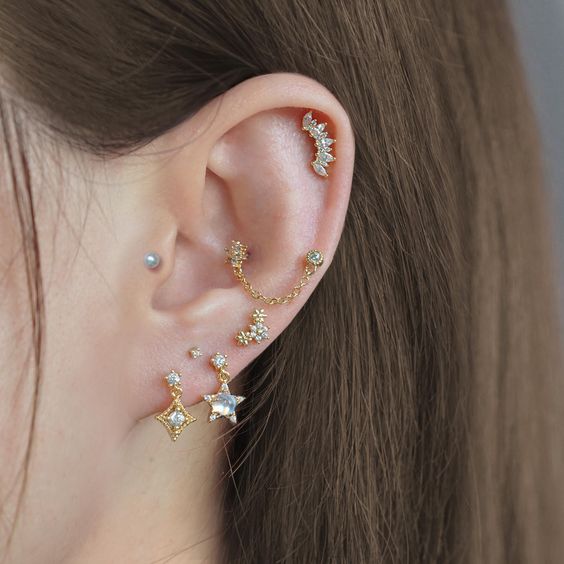Ear piercing is a popular and versatile form of body art, allowing individuals to express themselves through various piercing styles and jewelry. Whether you’re a first-timer or looking to expand your collection, knowing the different types of piercings, their healing times, and the best jewelry is crucial for a smooth experience. In this guide, we will cover the essentials of Ear Piercing in Dubai, including types, healing time, jewelry options, and aftercare.
Types of Ear Piercings:
Ear piercings come in several forms, depending on where they are placed on the ear. Here are the most common types:
1. Lobe Piercing:
The earlobe is the soft, lower part of the ear. It’s the most common and beginner-friendly piercing due to its minimal pain and quick healing time.
- Healing Time: 6-8 weeks
- Jewelry: Studs, small hoops, dangles
2. Helix Piercing:
Located along the upper cartilage, the helix piercing offers a stylish look for those seeking something beyond the earlobe.
- Healing Time: 3-6 months
- Jewelry: Small hoops, studs
3. Tragus Piercing:
This piercing is placed on the small flap of cartilage that partially covers the ear canal. Due to its location, it may be slightly more painful than other ear piercings.
- Healing Time: 3-6 months
- Jewelry: Small studs, captive bead rings
4. Daith Piercing:
The daith is located in the inner fold of the ear and is popular for its unique placement. Some believe it may alleviate migraines, though there’s no scientific backing for this claim.
- Healing Time: 6-9 months
- Jewelry: Small hoops, captive bead rings
5. Conch Piercing:
This piercing is in the cartilage inside the ear and can be either inner or outer, depending on its exact placement.
- Healing Time: 6-12 months
- Jewelry: Hoops, flat-back studs
Healing Process and Aftercare:
Healing times vary depending on the location of the ear piercing. Earlobe piercings heal faster due to the soft tissue, while cartilage piercings can take much longer and require more care.
General Aftercare Tips:
- Clean with saline: Use a saline solution twice a day to clean your piercing.
- Avoid touching: Only touch your piercing with clean hands to avoid introducing bacteria.
- Stay away from irritants: Keep hair products, lotions, and makeup away from your piercing.
- Be patient: Cartilage piercings can take up to a year to fully heal, so avoid changing your jewelry too soon.
Healing Times:
- Lobe: 6-8 weeks
- Helix/Tragus/Daith/Conch: 3-12 months
Choosing the Right Jewelry:
Jewelry choice is not just about aesthetics; it’s also about comfort and safety, especially during the healing process. High-quality materials are essential to prevent irritation and ensure smooth healing.
Best Materials for Piercing Jewelry:
- Surgical Steel: Hypoallergenic and durable, making it a great option for new piercings.
- Titanium: Lightweight and highly biocompatible, perfect for sensitive skin.
- 14K-18K Gold: For those who prefer gold, make sure it’s of high quality to avoid irritation.
- Niobium: A hypoallergenic metal that’s great for people with metal sensitivities.
- Platinum: Premium and hypoallergenic but more expensive than other options.
Jewelry Styles:
- Studs: Simple and secure, ideal for healing.
- Hoops: Best for healed piercings; they can snag on clothing, so it’s best to wait until your piercing is fully healed.
- Captive Bead Rings: A common choice for cartilage piercings, providing flexibility and style.
Conclusion:
Ear piercing is a versatile and stylish form of self-expression, offering a range of options from simple lobe piercings to intricate cartilage styles. While the process is relatively simple, it’s important to understand the healing times, aftercare routines, and appropriate jewelry to ensure your piercing heals properly and remains healthy. By selecting high-quality materials and committing to a good aftercare routine, you can minimize complications and enjoy your new piercings for years. Whether you’re a piercing enthusiast or a first-timer, this guide offers the essential information you need to make informed decisions about your next ear piercing adventure.
Common FAQs About Ear Piercings:
1. Does getting an ear piercing hurt?
Pain levels depend on the location. Earlobe piercings are generally less painful, while cartilage piercings may cause more discomfort due to the thicker tissue.
2. How long does it take for an ear piercing to heal?
Earlobe piercings heal in about 6-8 weeks, but cartilage piercings can take 3-12 months to fully heal.
3. What should I use to clean my piercing?
Use a saline solution or piercing aftercare spray to clean your piercing twice a day. Avoid using alcohol or hydrogen peroxide, as they can dry out the skin and delay healing.
4. When can I change my jewelry?
You can change your earlobe jewelry after 6-8 weeks, but cartilage piercings should not be changed until after 3-6 months, or when they are fully healed.
5. Can I swim after getting my ears pierced?
It’s best to avoid swimming in pools, oceans, or hot tubs until your piercing is fully healed to prevent infections caused by bacteria in the water.
6. Is it safe to get multiple piercings at once?
Yes, but healing multiple piercings can take longer, and it requires more aftercare. Make sure you’re committed to a proper cleaning routine.
7. What should I do if my piercing becomes infected?
If you notice redness, swelling, or discharge that doesn’t improve, consult a professional piercer or healthcare provider. Early intervention can prevent more serious infections.
8. How do I prevent piercing bumps or keloids?
Bumps can result from irritation, improper aftercare, or infection. To prevent them, follow a strict cleaning routine, avoid touching the piercing, and use hypoallergenic jewelry.



